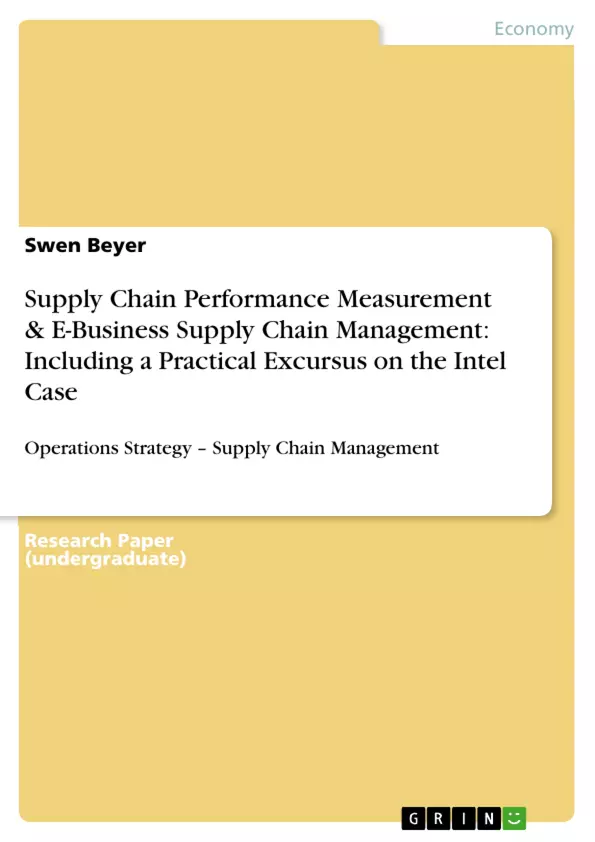The environmental surroundings of most companies have changed radically in recent years. Especially the competitive pressure has risen substantially over the past decades, fuelled by an increased globalization of markets and supply chains. In order to continuously satisfy consumer needs in a timely manner, organizations have to focus on performance and efficiency improvement measures. In terms of supply chain management, performance includes the three dimensions efficiency, effectiveness and flexibility which have to be dealt with on an equal basis. One mean to improve supply chain performance is the linkage between various IT applications involved in the whole supply chain. These efforts and trends are treated under the term electronic supply chain management (E-SCM). There are three major critical success factors for the successful operation of an electronic supply chain. These can be clustered into decision motivation (e.g. a shared vision and a strong motivation), implementation process (e.g. the tight integration of inter-organizational information systems and the re-engineering of inter-organizational business processes) and infrastructure conditions (e.g. agreement upon a shared industry standard). There are numerous benefits of an E-SCM implementation such as increased communication speed and decreased cost in terms of communication, inventory and customer service. Furthermore, E-SCM allows mitigating the bullwhip effect by improv-ing the availability of information throughout the entire supply chain. In addition E-SCM allows organizations to implement an entirely pull-based approach. One downside of E-SCM is the need to make a company’s entire business processes transparent, also towards supply chain partners who might be engaged with competitors. A further danger of E-SCM is to over-rely on speed rather than on flexibility.
Inhaltsverzeichnis (Table of Contents)
- ABSTRACT.
- INTRODUCTION AND RESEARCH PURPOSE..
- THE UNDERLYING CONCEPT OF SUPPLY CHAIN MANAGEMENT
- SUPPLY CHAIN MANAGEMENT AS A SUCCESS FACTOR
- DEFINITIONS AND OBJECTIVES.
- SUPPLY CHAIN PERFORMANCE MEASUREMENT.
- CONCEPT OF PERFORMANCE MEASUREMENT
- BENEFITS
- CHALLENGES
- FRAMEWORKS.
- SCOR-model.
- The Balanced Scorecard.
- THE RELATIONSHIP BETWEEN ERP, SCM & E-COMMERCE
- E-BUSINESS IN SUPPLY CHAIN MANAGEMENT
- DEFINITION
- ELECTRONIC SUPPLY CHAIN MANAGEMENT.
- History.
- IT in Supply Chain Management
- The Impact of IT on Supply Chain Integration and Performance............
- Critical Success Factors for Inter-organizational Information Systems
- BENEFITS
- DRAWBACKS..
- CASE STUDY: INTEL & ROSETTANET.
- ROSETTANET AS AN EXAMPLE FOR AN E-SCM SYSTEM
- IMPLEMENTATION OF ROSETTANET AT INTEL...
- CONCLUSION.
Zielsetzung und Themenschwerpunkte (Objectives and Key Themes)
This paper explores the fundamental concepts of supply chain management, its integration into business processes, and the role of E-Businesses within this context. It analyzes the challenges and success factors associated with E-Supply Chain solutions, culminating in a case study of Intel's implementation of the RosettaNet system.
- The emergence and importance of supply chain management as a success factor in today's dynamic business environment.
- The critical role of information and communication technology (IT) in supply chain performance measurement and management.
- The benefits and drawbacks of Electronic Supply Chain Management (E-SCM) for companies, including its impact on communication, inventory, and customer service.
- The significance of inter-organizational information systems and business process re-engineering in the successful implementation of E-SCM.
- The application of E-SCM in practice, illustrated by the case study of Intel and its use of the RosettaNet system.
Zusammenfassung der Kapitel (Chapter Summaries)
- The abstract provides an overview of the paper's focus on supply chain performance and the role of Electronic Supply Chain Management (E-SCM) in improving efficiency, effectiveness, and flexibility.
- The introduction outlines the changing business landscape and increased competitive pressures facing companies today, leading to a focus on improving performance and efficiency in supply chains.
- Chapter 3 delves into the concept of supply chain management as a success factor, discussing its evolution and the need for a global optimization approach in the face of complex value chains.
- Chapter 4 examines supply chain performance measurement, exploring the concept, its benefits and challenges, and various frameworks like the SCOR model and the Balanced Scorecard.
- Chapter 5 explores the relationship between ERP, SCM, and E-Commerce, emphasizing the role of technology in integrating different aspects of supply chain management.
- Chapter 6 focuses on E-Business in supply chain management, defining the concept, tracing its history, and analyzing the impact of IT on supply chain integration and performance. It also delves into critical success factors for inter-organizational information systems, the benefits and drawbacks of E-SCM, and the importance of communication and transparency.
- Chapter 7 presents the case study of Intel and its implementation of the RosettaNet system as an example of a successful E-SCM solution.
Schlüsselwörter (Keywords)
This paper examines the crucial aspects of Supply Chain Management (SCM), specifically focusing on performance measurement and the utilization of Electronic Supply Chain Management (E-SCM) to enhance efficiency, effectiveness, and flexibility. It explores the impact of Information Technology (IT) on inter-organizational information systems and business processes, highlighting key success factors for its effective implementation. The case study of Intel and its use of RosettaNet serves as a practical example of E-SCM in action. The paper further analyzes the benefits and challenges associated with E-SCM, including considerations for communication, transparency, and mitigating the bullwhip effect.
- Quote paper
- Swen Beyer (Author), 2010, Supply Chain Performance Measurement & E-Business Supply Chain Management: Including a Practical Excursus on the Intel Case, Munich, GRIN Verlag, https://www.grin.com/document/153242



